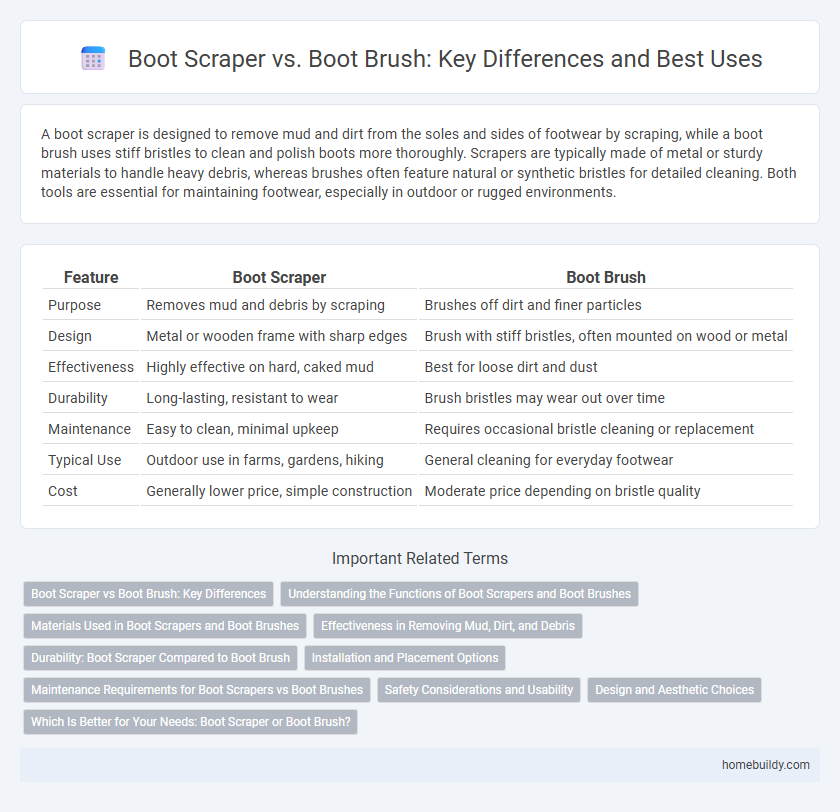A boot scraper is designed to remove mud and dirt from the soles and sides of footwear by scraping, while a boot brush uses stiff bristles to clean and polish boots more thoroughly. Scrapers are typically made of metal or sturdy materials to handle heavy debris, whereas brushes often feature natural or synthetic bristles for detailed cleaning. Both tools are essential for maintaining footwear, especially in outdoor or rugged environments.
Table of Comparison
| Feature | Boot Scraper | Boot Brush |
|---|---|---|
| Purpose | Removes mud and debris by scraping | Brushes off dirt and finer particles |
| Design | Metal or wooden frame with sharp edges | Brush with stiff bristles, often mounted on wood or metal |
| Effectiveness | Highly effective on hard, caked mud | Best for loose dirt and dust |
| Durability | Long-lasting, resistant to wear | Brush bristles may wear out over time |
| Maintenance | Easy to clean, minimal upkeep | Requires occasional bristle cleaning or replacement |
| Typical Use | Outdoor use in farms, gardens, hiking | General cleaning for everyday footwear |
| Cost | Generally lower price, simple construction | Moderate price depending on bristle quality |
Boot Scraper vs Boot Brush: Key Differences
Boot scrapers efficiently remove heavy mud and debris by scraping the sole and sides of boots, while boot brushes excel at brushing away finer dirt and dust particles. Boot scrapers usually feature sturdy metal blades for scraping, whereas boot brushes have bristles made from wire or stiff fibers designed for thorough cleaning. Choosing between a boot scraper and a boot brush depends on the type of soil and the cleaning requirement, with scrapers ideal for compacted mud and brushes suited for lighter dirt removal.
Understanding the Functions of Boot Scrapers and Boot Brushes
Boot scrapers efficiently remove thick mud and debris from shoe soles using rigid metal or wooden blades, preventing dirt from entering indoor spaces. Boot brushes, featuring stiff bristles, are designed to clean finer particles and dust from boots, enhancing cleanliness and appearance. Differentiating these tools based on their specific functions ensures effective maintenance of footwear hygiene in various environments.
Materials Used in Boot Scrapers and Boot Brushes
Boot scrapers are typically made from durable materials such as cast iron, steel, or heavy-duty wood, designed to withstand outdoor elements and provide sturdy removal of mud and debris. In contrast, boot brushes often use stiff nylon, horsehair, or wire bristles attached to wooden or plastic bases to effectively clean dirt and fine particles from boots. The choice of materials directly impacts the durability and cleaning efficiency of both boot scrapers and boot brushes in outdoor and indoor environments.
Effectiveness in Removing Mud, Dirt, and Debris
Boot scrapers provide superior effectiveness in removing caked-on mud, dirt, and debris thanks to their rigid metal blades that penetrate deep into grooves and cleats. Boot brushes, featuring bristles, excel at dislodging loose dirt and finer particles but struggle with hardened or embedded mud. For heavy-duty cleaning, boot scrapers offer a more thorough and efficient solution, especially in muddy or rugged outdoor environments.
Durability: Boot Scraper Compared to Boot Brush
Boot scrapers often exhibit superior durability compared to boot brushes due to their robust metal or cast iron construction, making them resistant to wear and damage from heavy use. Unlike boot brushes, which feature bristles that can wear out or break over time, boot scrapers maintain effectiveness in removing stubborn mud and debris over years of repeated scraping. This durability makes boot scrapers a long-lasting choice for outdoor environments where heavy-duty cleaning tools are essential.
Installation and Placement Options
Boot scrapers offer versatile installation options, including ground-mounted, wall-mounted, or integrated into steps, making them ideal for various outdoor environments. Their strategic placement near entryways or garden paths effectively removes mud and debris before entering indoor spaces. Boot brushes, while effective for cleaning, typically require wall mounting and less durable placement options, limiting their flexibility compared to boot scrapers.
Maintenance Requirements for Boot Scrapers vs Boot Brushes
Boot scrapers require minimal maintenance, typically involving occasional rust prevention and debris removal to ensure effective scraping. In contrast, boot brushes demand more frequent cleaning to prevent bristle wear and buildup of mud or dirt, which can reduce their efficiency. The durability of metal or sturdy plastic scraper blades often outlasts the softer bristles of boot brushes, making scrapers preferable for low-maintenance environments.
Safety Considerations and Usability
Boot scrapers provide a safer option than boot brushes by minimizing the risk of slipping through sturdy metal or cast iron construction that securely removes mud and debris. Unlike boot brushes, which require more vigorous scrubbing and can lead to accidental contact with sharp bristles, boot scrapers offer a more controlled and stable cleaning process. Usability improves with boot scrapers as they accommodate various boot types and require less physical effort, making them ideal for users prioritizing safety and convenience.
Design and Aesthetic Choices
Boot scrapers typically feature sturdy metal blades or bars arranged in a simple, utilitarian design optimized for removing mud and dirt efficiently. In contrast, boot brushes often incorporate bristles made of natural fibers or synthetic materials, blending functionality with decorative wooden or cast-iron frames that enhance their visual appeal. The design choices of boot scrapers prioritize durability and effectiveness, while boot brushes balance aesthetics and cleaning versatility.
Which Is Better for Your Needs: Boot Scraper or Boot Brush?
A boot scraper is highly effective for removing thick mud and large debris from footwear, making it ideal for outdoor, rugged environments. A boot brush excels at cleaning finer dirt and grime, offering a gentler option for delicate boots or shoes requiring detailed maintenance. Choosing between a boot scraper and a boot brush depends on your typical conditions and cleaning needs, with scrapers suited for heavy-duty use and brushes better for routine, thorough cleaning.
boot scraper vs boot brush Infographic

 homebuildy.com
homebuildy.com